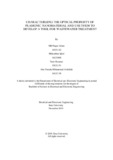| dc.contributor.advisor | Kabir, S. M. Lutful | |
| dc.contributor.author | Islam, Md. Faqrul | |
| dc.contributor.author | Iqbal, Mehzabien | |
| dc.contributor.author | Rahman, Tasin | |
| dc.contributor.author | Abdullah, Abu Yousha Mohammad | |
| dc.date.accessioned | 2020-02-05T05:53:58Z | |
| dc.date.available | 2020-02-05T05:53:58Z | |
| dc.date.copyright | 2019 | |
| dc.date.issued | 2019-12 | |
| dc.identifier.other | ID 16321142 | |
| dc.identifier.other | ID 16121048 | |
| dc.identifier.other | ID 19121151 | |
| dc.identifier.other | ID 16121138 | |
| dc.identifier.uri | http://hdl.handle.net/10361/13736 | |
| dc.description | This thesis is submitted in partial fulfillment of the requirements for the degree of Bachelor of Science in Electrical and Electronic Engineering, 2019. | en_US |
| dc.description | Cataloged from PDF version of thesis. | |
| dc.description | Includes bibliographical references (pages 56-64). | |
| dc.description.abstract | Water pollution is one of the vital problems in Bangladesh. This problem is increasing with the huge number of population and implementation of proper management system. Our thesis work is mainly focused on water purification in order to use it in our daily activities. For this purpose, we choose nanoparticle to refine water. To do so, we did a systematic analysis to characterize the silver and gold nanoparticle by using Finite Difference Time Domain (FDTD) (lumerical solution Inc.) simulation for numerical analysis and Mie theory for analytical analysis. Further, we did some experiments to identify different types of bonding, presence of elements and their quantity, pH level in wastewater sample, which was collected from different sources. This paper shows some graphical analysis to observe the scattering, absorption and extinction characteristics of nanoparticle, demonstrates the technique to identify the presence of nanoparticle in wastewater sample through extensive simulations and rigorous experiments. Our tool is not only for characterization of nanoparticle but also identify the harmful molecules that are present in our sample, which leads to remove those molecules in future. To conclude, we have developed a technique that not only identifies the existence of nanoparticles in wastewater, but can also be used to refine wastewater and reuse wastewater. | en_US |
| dc.description.statementofresponsibility | Md. Faqrul Islam | |
| dc.description.statementofresponsibility | Mehzabien Iqbal | |
| dc.description.statementofresponsibility | Tasin Rahman | |
| dc.description.statementofresponsibility | Abu Yousha Mohammad Abdullah | |
| dc.format.extent | 64 pages | |
| dc.language.iso | en | en_US |
| dc.publisher | Brac University | en_US |
| dc.rights | Brac University theses are protected by copyright. They may be viewed from this source for any purpose, but reproduction or distribution in any format is prohibited without written permission. | |
| dc.subject | Water pollution | en_US |
| dc.subject | Plasmonic nanomaterial | en_US |
| dc.subject | Wastewater treatment | en_US |
| dc.subject | Finite Difference Time Domain (FDTD) | en_US |
| dc.subject.lcsh | Nanotechnology | |
| dc.subject.lcsh | Sewage disposal plants | |
| dc.title | Characterizing the optical property of plasmonic nanomaterial and use them to develop a tool for wastewater treatment | en_US |
| dc.type | Thesis | en_US |
| dc.contributor.department | Department of Electrical and Electronic Engineering, Brac University | |
| dc.description.degree | B. Electrical and Electronic Engineering | |

